Javed Bari , Faria Tabassum , Md. M. I. Sadi , Md. H. Islam , Md. Ashif Iqbal
Department of Civil & Environmental Engineering, North South University, Dhaka, Bangladesh
Correspondence to: Javed Bari , Department of Civil & Environmental Engineering, North South University, Dhaka, Bangladesh.
| Email: |  |
Copyright © 2020 The Author(s). Published by Scientific & Academic Publishing.
This work is licensed under the Creative Commons Attribution International License (CC BY).
http://creativecommons.org/licenses/by/4.0/

Abstract
This paper presents the findings of a research study conducted to evaluate the status and prospect of the existing water taxi service in Hatirjheel, which is the largest water body inside Dhaka City - the capital of Bangladesh. The evaluation was done using key informants’ interviews (KII), questionnaire-based surveys of the stakeholders and on-site observations. While the KII was used to learn about the system and corresponding area, the questionnaires for operates, workers and users were used to learn about the full system. The potential, existing problems and suggestions could be learned and analyzed. Although this water taxi system was found to be vital for saving travel time, reducing traffic jam and reducing traffic accidents, its own problems could reduce the anticipated benefits as well. Travel time and cost estimations were performed in this study as well, which showed how vital the system can be, in terms of savings regarding both travel time and cost. The initial purpose of the study is to look into the system. However, with enormous suggestions from both workers and passengers, the findings and analyses led the study to inscribe remedies as well.
Keywords:
Water taxi, Key informants’ interview (KII), Travel time, Travel cost
Cite this paper: Javed Bari , Faria Tabassum , Md. M. I. Sadi , Md. H. Islam , Md. Ashif Iqbal , A Comprehensive Evaluation of the Hatirjheel Water Taxi Service of Dhaka City – the Capital of Bangladesh, International Journal of Advanced and Multidisciplinary Engineering Science, Vol. 3 No. 1, 2020, pp. 1-7. doi: 10.5923/j.james.20200301.01.
1. Introduction
With a population of about 20 million and 36 percent of the country’s urban population, Dhaka, the capital of Bangladesh, is considered one of the most densely populated cities in the world [1,2]. It is also ranked as the fourth least liveable city in the world [3]. During 2007 and 2017, the average traffic speed has dropped from 21 km/hour to 7 km/hour, only slightly above the average walking speed, while congestion is eating up about 3.2 million working hours per day [2]. An article in Encyclopaedia Britannica mentions, “Inland navigation is important in certain countries; a good river and canal system is capable of carrying goods and passengers at small cost over considerable distances. Among the countries with well-developed inland water transport systems are Bangladesh, the countries of mainland Southeast Asia, and China” [4].Bangladesh is globally well known as a riverine country with over 700 rivers and a huge number of streams and canals. The length of the water body approximately is 24,000 km, out of which 5,970 km is navigable by mechanized vessels [5]. Unfortunately, the prospect of using inland waterways as an effective mode of urban traffic transportation system has long been overlooked by the planners [5]. A modal shift away from road transport to inland water transport could not only enhance traffic mobility, but also generate safety benefits, as it may replace heavy goods vehicles, which are responsible for a disproportionate amount of traffic accidents [6].With about 302-acre area, Hatirjheel had been the biggest unused water body situated right in the middle of Dhaka city. It has been recently renovated, and a water taxi service has been in place since late December 16, 2016. Developed country has already proved that the water taxi service can be quite profitable with proper implementation. In 2010, Bangladesh Inland Water Transport Corporation (BIWTC) introduced a 16-kilometer long water taxi service between Sadarghat and Gabtoli of Dhaka. Unfortunately, the service has been discontinued, due to management problems [7]. Therefore, it is crucial to evaluate the problems and prospects of the water taxi service at Hatirjheel to make it a sustainable and efficient mode of transportation.
2. Objective and Limitations
With this backdrop, the general objective of this research study was set to evaluate the status and prospect of the existing water taxi service in Hatirjheel in Dhaka, in terms of its operation, usage and time-cost efficiency. To accomplish the general objective, following specific objectives were set:1. to learn about the operational and physical characteristics of Hatirjheel inland water transportation system; 2. to evaluate the usage of the water taxi. 3. to calculate the time efficiency of this transportation system.4. to calculate the cost efficiency of this system.5. to find out the advantages, disadvantages, problems and possible remedies of the water taxi service.There were some limitations in the study. Most thoughtful steps were taken to conduct the study under negligible amount of errors. But the following limitations could not be avoided: • More secondary data could be gathered if the project-related official records were preserved and shared publicly. • No substantial research was conducted on this service in the past.• The survey sample size could be larger given more time and resources.
3. Methodology
3.1. Geographical Scope
The geographical extent of the study covered Hatirjheel - the only inland water transportation system in Dhaka. Its water taxi service route and process were evaluated in this study. There are 5 landing stations in the entire system and they cover a large area of the city from Gulshan-1 to Kawran Bazar (FDC) covering about 7 kilometers of equivalent road way. This service covers a large part of Badda and west Rampura area, which includes Uttar Badda, South Badda, Merul Badda, Ulan, Mirbag and Gabtola. It also gives service to people of Tejgaon and Mohakhali area.
3.2. Routes Evaluated
Even though there are five stations in the Hatirjheel area, one cannot go to each station separately as tickets are sold in the following variants, and as such, the following routes were evaluated:1. Hatirjheel water taxi service Rampura to Hatirjheel water taxi FDC and vice versa.2. Hatirjheel water taxi service Rampura to Gulshan water taxi terminal and vice versa.3. Hatirjheel water taxi service Rampura to Hatirjheel water taxi terminal police plaza and vice versa.4. Hatirjheel water taxi FDC to Gulshan water taxi terminal and vice versa. 5. Hatirjheel water taxi FDC to Rampura water taxi terminal Badda and vice versa.
3.3. Evaluation Techniques
Following major techniques were followed in this study:1. Stakeholders’ Survey (on management personnel, operators and passengers) based on interview and set questionnaire; 2. Site survey;3. Estimation of travel time and cost savings.The questionnaire-based surveys were further analyzed using both Microsoft Excel software and Statistical Package for the Social Sciences (SPSS) software.
3.3.1. Stakeholders’ Survey
(a) Key Informants’ Interview (KII) of Management Personnel: The KII was conducted to get a better idea of the system, so that the operators’ and the passengers’ questionnaires are accurate and fruitful. Most of the KII questions were the open-ended type that included questions related to management, capacity, boats, trips, cost, operational techniques, challenges, etc.(b) Questionnaire-based Operator’s Survey: This included categories such as age, qualification, salary, work responsibilities, characteristics of routes (busy, profitable, etc.), difficulties, recommendations, etc.(c) Questionnaire-based Passenger’s Survey: This included both close-ended and open-ended questions, as well as multiple-choice questions, which included gender, age, occupation, and frequency, purpose, difficulties, benefits (time. cost, etc.) of the water taxi use and recommendations for alternate route, improving management, etc.
3.3.2. Site Survey
Primary data collection was done on the surface transport alternative, water vessels, landing stations, service details, support services, water quality and waste management conditions, etc. This work was conducted utilizing detailed on-site engineering survey of the Hatirjheel water body and its adjacent roads and areas.
3.3.3. Estimation of Travel Time and Cost Savings
Furthermore, based on the field survey and passenger’s survey, estimations of savings in travel time and cost due to the water taxi service were also done.
3.4. Survey Sample Size
Initially, one KII with the project-related Assistant Engineer and four Operators’ Questionnaire-based Operator’s Surveys (on an assistant manager, a driver, a helper and a ticket checker) were conducted. Consequently, a Questionnaire-based Passenger Survey was conducted on 41 randomly selected passengers, with an 88% confidence level, based on a daily 1,000 ticket sells on average The randomization was stratified for five landing stations,.
4. Hatirjheel Water Taxi System
The physical constraints in the Hatirjheel Lake i.e. the width, draft and bends of the lake needed a water vessel with moderate speed and size with the special attention so that the operation of the vessel will not be a source of pollution of the lake and noise to the people living adjacent to the lake. Therefore, the water taxi being used at Hatirjheel was designed to have a speed of 7 knot, with a 4-stroke diesel-powered midrange outboard engine having 50 HP (horsepower) capacity [8]. The first water taxi at Hatirjheel Lake was first introduced on 16th December 2016. Engines of the water taxi were bought from China and assembled at a workshop in Chittagong, Bangladesh. The total cost for each taxi was 8.5 million BDT (Bangladesh Taka). It can carry 45 passengers at a time. The map of the Hatirjheel water body is shown in Figure 1 (courtesy of Google Maps). The Wahid Construction Company has taken the contract of water taxi service for 20 years. The time of the service is from 6:30am to 10:30pm every day. There are 5 stations covering a large area of Dhaka city from Gulshan-1 to Kawran Bazar (FDC), covering about 7 kilometers of equivalent road way.  | Figure 1. Map of Hatirjheel water body |
As noted earlier, this service covers a large part of Badda, West Rampura, Tejgaon and Mohakhali areas. The service runs on four routes, namely Gudaraghat in Gulshan-1 to FDC, Merul-Badda to FDC and FDC to Merul Badda and Gudaraghat. Each water taxi is supposed to have eight to ten life jackets and two lifeguards in it. Passengers are charged 90 Taka for round trips and 15 to 30 Taka for a single trip. As of end-2019, 1 US Dollar (USD) is equivalent to about 85 Taka (BDT).A few snapshots of the water taxi service are shown in Figure 2 and Figure 3.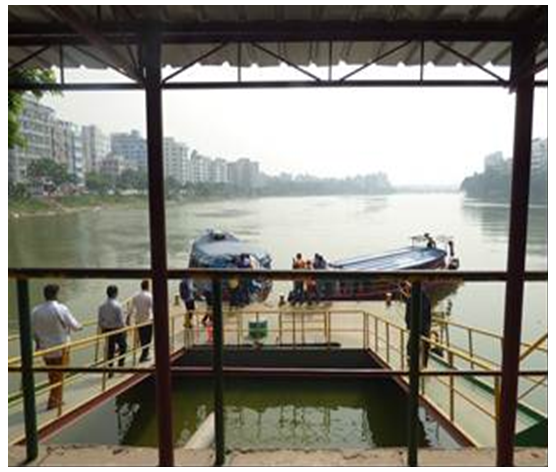 | Figure 2. Gulshan Water Taxi Terminal |
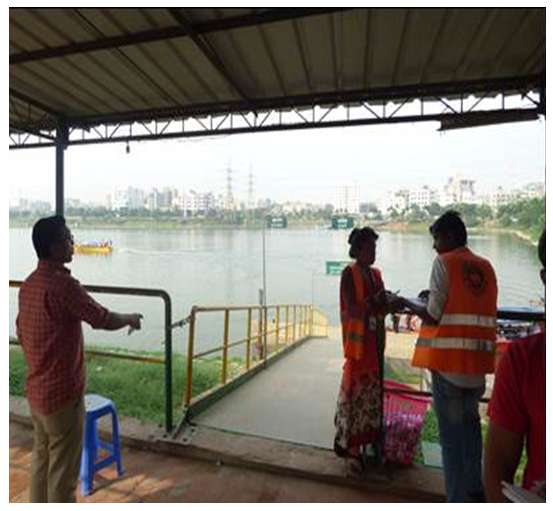 | Figure 3. Surveying being conducted at Rampura Water Taxi Terminal |
5. Analysis
5.1. Findings of Key Informants’ Interview
The survey team interviewed the Assistant Engineer in charge of the project. The most important findings obtained from the KII are as follows:- about total 375 trips per day;- total 15 boats ply on the Hatirjheel Waterway for the Water Taxi service;- there are two types boats – one is 20-seated 7.5m x 2.5m boat and the other is 30-seated 11.5m x 4m boat;- monthly maintenance cost per boat is about 10,000 to 15,000 Taka;- major beneficial points are as follows:• well-organized and smooth daily operation, and• overall profitable service;- major adverse points are: • service is running on a small-scale basis,• no life jacket is used,• water is getting polluted with time (has bad smell),• boats need frequent and costly maintenance works.
5.2. Findings of Operators’ Survey
As noted, the operators’ questionnaire-based survey was conducted on an assistant manager, a driver, a helper and a ticket checker. The most important findings obtained from the Operators’ Survey are as follows:- salary ranged from 9,000 Taka (Maintenance technician and Driver) to 15,000 Taka (Assistant Engineer);- the route having the highest number of passenger is Rampura to Gulshan-1;- major adverse points are: • operators’ salary is low;• water level (i.e. draft) becomes low during the dry season,• water is polluted,• there are less regular passengers than tourists, • existing engines are not high-quality engines, and • number of water taxis is inadequate during morning and afternoon peak times.
5.3. Findings of Passengers’ Survey
Note that a questionnaire-based survey was conducted on 41 randomly selected passengers (stratified for five landing stations). The major information obtained from these surveys is shown in Figures 4 through 12.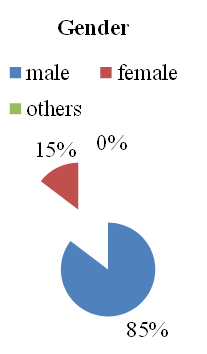 | Figure 4. Gender of passengers surveyed |
 | Figure 5. Age of passengers surveyed |
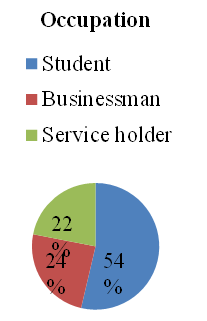 | Figure 6. Occupation of passengers |
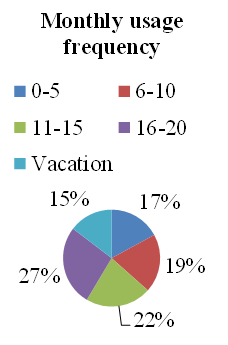 | Figure 7. Usage frequency of passengers |
 | Figure 8. Usage difficulty of passengers |
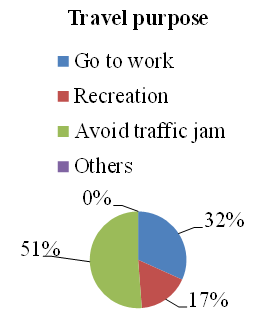 | Figure 9. Travel purpose of passengers |
 | Figure 10. Benefits of passengers |
 | Figure 11. Problems of passengers |
 | Figure 12. Passengers’ savings in travel time per trip |
The summary information of this survey is as follows:- the adverse points are: • female passengers are less attracted by the service,• life jacket is unavailable both in boat and at landing stations,• some passengers are afraid of falling off and mugging,• water is polluted and odorous,• full ride information is not available,• waiting time is high during morning and afternoon, • fare seems high, and• engines are noisy.- beneficial points are: • the service has good demand,• easy to use,• more popular among young people,• the service saves time, as well as is entertaining.
5.4. Estimation of Cost and Time Savings per Person
Per capita time and cost were estimated based on actual route survey. Cost per hour and timesaving of an average passenger were estimated as follows [9]:Hourly transportation cost = (Average monthly salary in Bangladesh)/(4.345 x working days x working hours) = (57,945)/(4.345 x 5 x 8)= 333 Taka. Time saved in water taxi (comparing between public transportation and water taxi)= Time on land way - Time on waterwayMoney saved in water taxi = (Time saved) x (Hourly transportation cost).Average time saved by water taxi service considering at five routes (in minutes)= (Total time saved) / (Number of routes)= (8+6+4+13+9) / 5 = 8 minutes.Average cost saved by water taxi service considering all five routes (in Taka per hour)= (43.34+33.34+22.22+72.25+50.00) / 5= 44.23 Taka/hour.
5.5. Recommended Remedies of Major Problems
Based on the analysis, the major problems and their recommended remedies are as follows:Problem#1- Less water in winter (dry season): • Hatirjheel is connected with “Balu River” through Khilgaon, and then finally connected with “Sitolokkha River”. • Proper water gate through these channels could be used to get more water flow during winter.Problem#2- High waiting time at morning and afternoon peak times: • A more rational time schedule with variable taxi frequency can fix the problem. • Tourists may also be discouraged during the peak times, or tourists can be put into separately identified boats. • Another option is increasing the number of boats.Problem#3- Water pollution and resulting odor: • Many local residents around the lake use it as a depository of sewerage, which needs to be stopped immediately (see Figure 13). • Oxygenating the water by using fountains and using screens are good remedies, which already exist in the system (see figures 14 and 15, respectively). However, they seem to be inadequate and need to be made more effective by cleaning more frequently and/or increasing numbers. | Figure 13. Sewerage discharging into the lake |
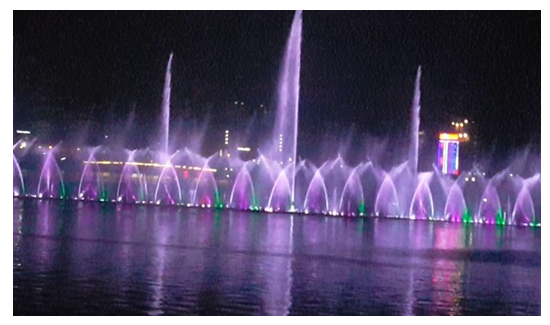 | Figure 14. Oxygenating process of the lake |
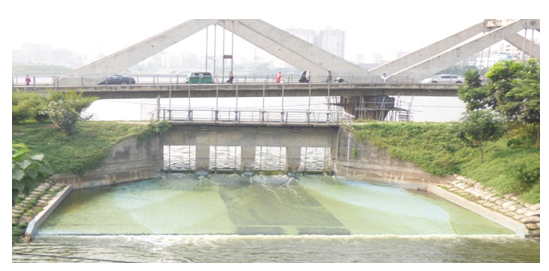 | Figure 15. Waste screening process of the lake |
Problem#4- Boats are noisy and need frequent and expensive maintenance works: • Authority should gradually replace existing boats with better quality boats (i.e. better body and engine). • Engine sound could be further reduced by using a proper sound dampening mechanism.Problem#5- Passengers feel unsafe in boats and female passengers are less attracted: • There must be adequate life jackets for all passengers inside the boat. • The security at the landing station should be enhanced as well. • The boats should be made more user-friendly and safe for females as well as people with special needs.Problem#6- Full ride information is not available: • Full ride information must be available at the landing station, ticket counter and inside boats.
6. Conclusions and Recommendations
6.1. Conclusions
Hatirjheel water taxi is a very promising field of transportation for the Dhaka mega-city. The KII, operators’ interview and passengers’ survey, combined with on-site investigation provided a good understanding of the promises and problems of this urban inland waterway system. The study also provided recommendations for mitigating the problems of the existing system, as well as for improving the service. The study showed that water taxi could be a sustainable, timesaving and cheap transport service for the citizens of a mega city like Dhaka.
6.2. Recommendations for Future Research
The authors have identified following recommendations for future research:• implement the suggestion provided in this study and conduct a “before-after” impact evaluation study, in a few years, say two to three years later.• introduce water taxi service in other big cities, where large water bodies are present.• role of water taxi in the traffic jam-reduction of Dhaka city could be studied rigorously.• implement the suggestion provided in this study and conduct a “before-after” impact evaluation study, in a few years, say two to three years later. • introduce water taxi service in other big cities, where large water bodies are present.• role of water taxi in the traffic jam-reduction of Dhaka city could be studied rigorously.
ACKNOWLEDGMENTS
The authors are grateful to concerned officers of Bangladesh Army and Wahid Construction Company, as well as Mr. M. G. Sabbir of North South University, for helping in the survey work.
References
| [1] | Dhaka Transport Coordination Authority, “Revised Strategic Transport Plan for Dhaka (RSTP)”. Bangladesh Government, 2015. |
| [2] | The World Bank, “A Modern Dhaka is Key to Bangladesh’s Upper-Middle Income Country Vision”, July 19, 2017. |
| [3] | Mahmood, A., “Dhaka retains 4th least livable city position in Global Livability Index”, The Dhaka Tribune, (2017, August 17), Retrieved from: www.dhakatribune.com/, Accessed June 1, 2019. |
| [4] | Gourou, Pierre, et al., “Encyclopedia Britannica – Asia”, October 15, 2018, Retrieved from: www.britannica.com/place/Asia. Accessed July 20, 2019. |
| [5] | Mahmud, S. S., Rahman, M. W., and Rabbi, S. H. E., “Transport System in Bangladesh: Issues and Options for Sustainable Development”, Accident Research Center (currently known as Accident Research Institute), BUET, Dhaka, Bangladesh, 2006. |
| [6] | Asian Development Bank, “Asia’s Rivers and Canals: Inland Waterway Transport”, December 19, 2017, Retrieved from: www.adb.org/features/making-asia-flow-inland-waterway-transport. Accessed April 15, 2019. |
| [7] | Khan, A. R., “Waterbus service, a flop story”, Newspaper article, the Daily Independent, Dhaka, Bangladesh, May 16, 2016. |
| [8] | Rahaman, M. M., Rahman, M. H., Hashem, M. A., & Islam, M. R., “Design Study of Boat for Gulshan-Banani-Hatirjheel Lake in the Capital City of Bangladesh”, Procedia Engineering, Dhaka University Journal of Biological Science, Vol. 194, pp.211-217, 2017. |
| [9] | Salaryexplorer, “Average Salary in Bangladesh 2018”, 2018, Retrieved from: https://0x9.me/H9rYx. Accessed June 15, 2019. |


















 Abstract
Abstract Reference
Reference Full-Text PDF
Full-Text PDF Full-text HTML
Full-text HTML